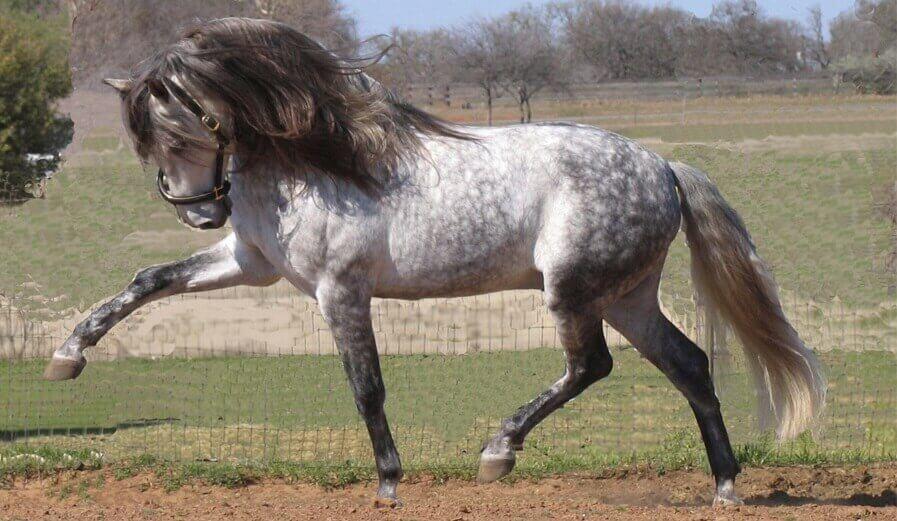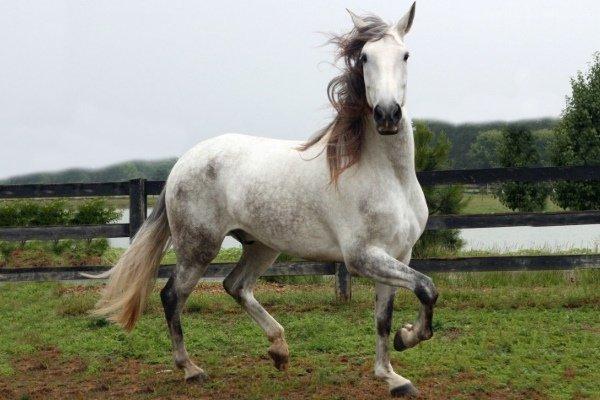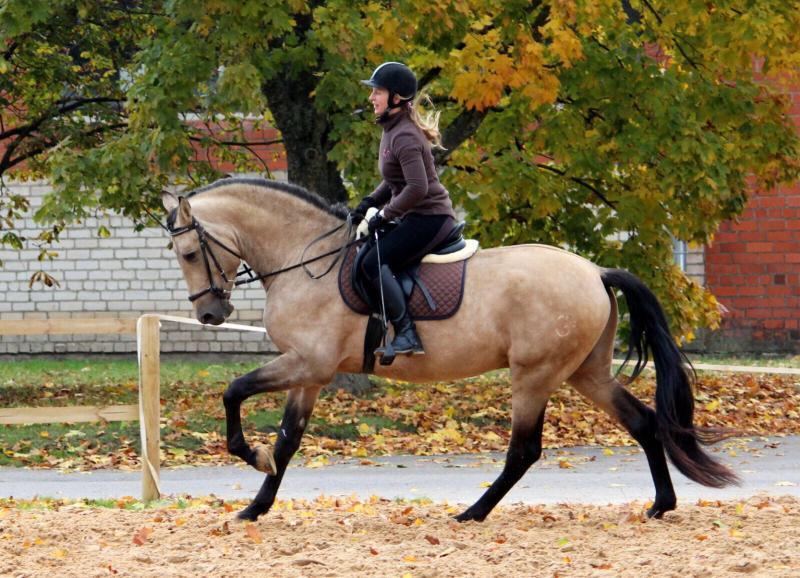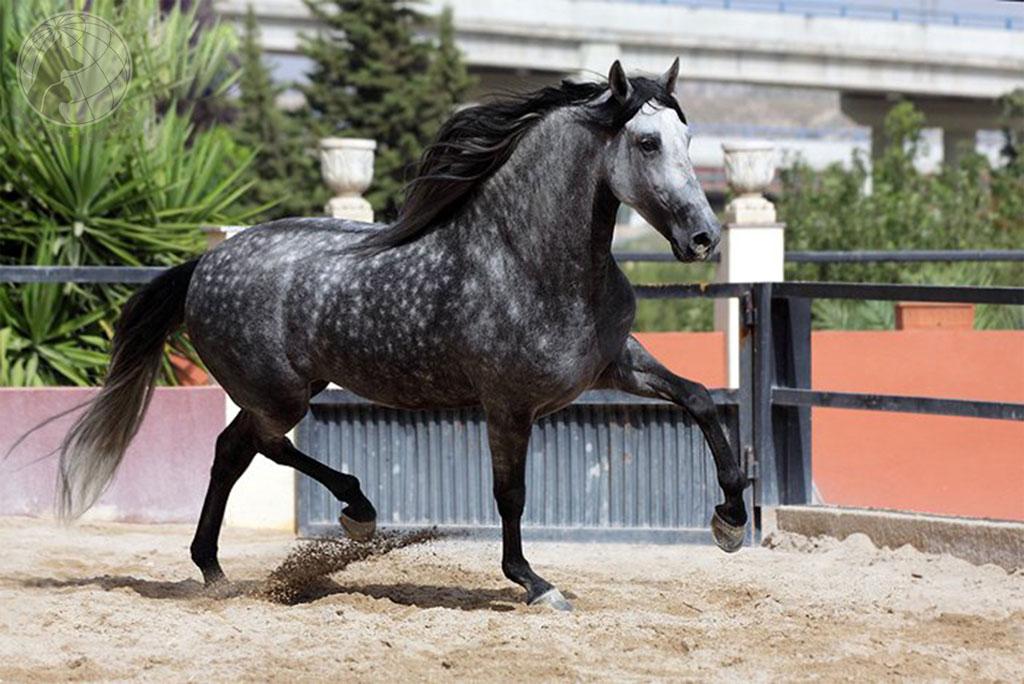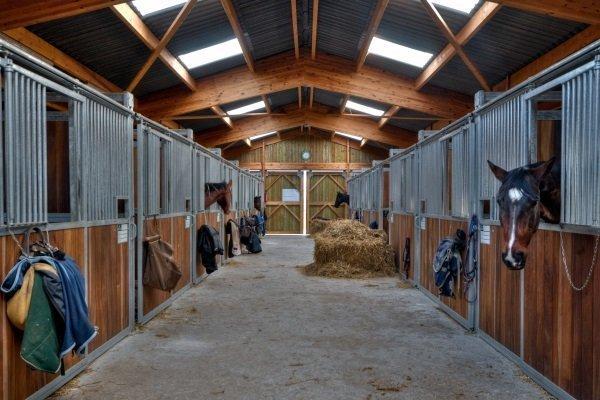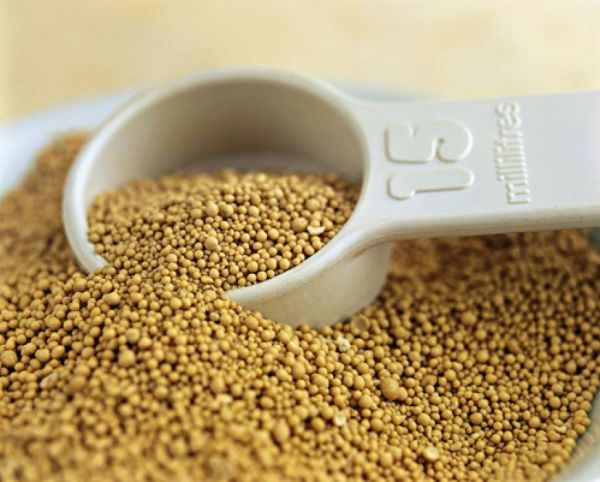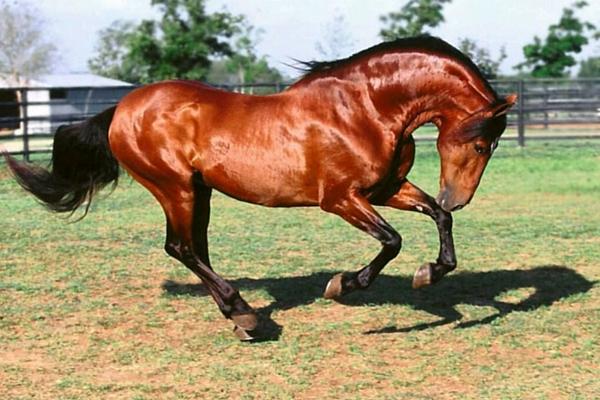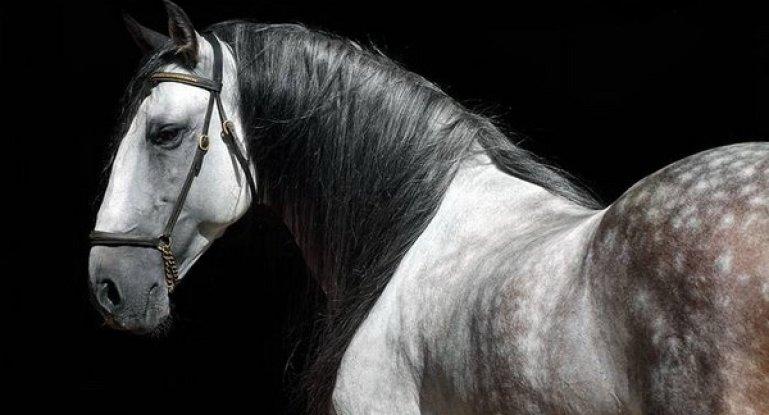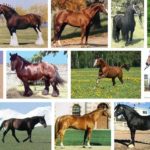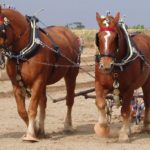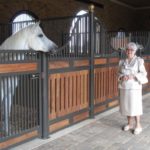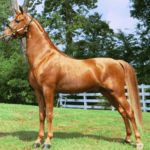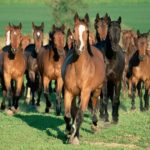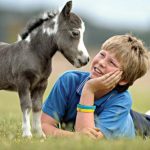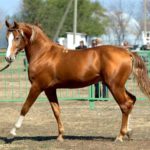Andalusians are among the elite horse breeds, famous for their spectacular exterior, endurance, easy movement, agility and dexterity. The breed has been improved in Spain for many centuries. As a result, the Andalusian (Pura Raza Espanola) horse turned into a graceful animal, best for ceremonial rides and military operations. Nowadays, Andalusians win equestrian competitions and are bred for walking and pleasure.
- Origin
- Pros and cons of the Andalusian
- Features and description of the Andalusian horse
- Exterior
- Varieties of Spanish horse colors
- Animal temperament and trainability
- Wild Lifestyle
- Where is it used?
- Features of keeping a horse
- Arrangement of the stables
- Feeding and watering
- Basic diet
- Nutritional supplements
- Hygiene and horse care
- Grazing
- Horseshoe
- Disease Prevention
- Breeding
- Where to buy and how much does it cost?
- Interesting Facts
Origin
The ancestors of the Andalusian horse were wild horses from the south of Spain, and the name corresponds to the province (Andalusia) where the animals were bred. The breed was formed over 2-3 millennia; it is one of the oldest types of horses. The turbulent history of the Iberian Peninsula had a significant impact on the development of the breed - after the capture of the territory by the Moors, local horses were crossed with Barbary horses. Frankish and Germanic horses also contributed to improving the characteristics of local animals.
In the 15th century, Andalusian horses gained European fame and served to improve many horse breeds. The Andalusians had impressive performance and external characteristics; thanks to their easy handling and maneuverability, they were ideal in battle. Royal houses and the top of the aristocracy used Andalusian horses for ceremonial rides. Brave and resilient horses helped the conquistadors conquer America.
Pros and cons of the Andalusian
For many years, with the help of the Andalusian horse, the characteristics of European horses were corrected and used to improve many breeds. Beauty, grace, extraordinary movement with high lifting of the front legs makes the Andalusians the decoration of parades and shows.
The horse is classified as a universal breed. Andalusians are hot-tempered and temperamental, but obedient, obey the rider well, are smart, and readily follow commands. The combination of agility and agility, affection for the owner, and learning ability are the properties of elite horses with impressive intelligence and a kind, easy-going disposition.
Disadvantages of Andalusian riding horses:
- Training and training of horses begins at 3-4 years old; Andalusians are not a precocious breed.
- High prices for horses and late training make the business unprofitable. Selling an expensive purebred Andalusian in Russia is difficult.
- Horses are not used for racing.
- Horses are heat-loving and require regular walking. In winter, the Andalusian needs insulated stables and blankets for going outside.
- Light colored horses often suffer from skin diseases.
In Spain and many countries, Andalusian horses are actively bred; their number in the world exceeds 200 thousand heads.
Features and description of the Andalusian horse
Horses of the Andalusian breed are distinguished by a peculiar step due to the structure of the limbs and body - the front legs rise to the chest, the croup is smooth and compact. The peculiarities of the build and training turn each performance of the purebred Andalusian into a breathtaking spectacle, almost a dance. The shift of the center of gravity to the croup gives the horses mobility and easy controllability, which was a plus in battle.
Exterior
The rounded croup of the horse is reminiscent of the presence of oriental blood in Andalusian horses. From Arabian and Akhal-Teke horses The Spaniards are distinguished by their power and larger body. Exterior Features:
- height – 1.5-1.6 meters;
- medium-sized head with a slight bend in the nose;
- high neck with a crest and a noble carriage of the head;
- the back is straight, the croup is rounded, the tail is set low;
- wide chest with pronounced muscles;
- legs of medium length, dry, with strong large hooves;
- almond-shaped eyes;
- mane, bangs, tail - lush, silky.
The horse gives the impression of power and grace at the same time, intelligent eyes indicate intelligence and quick wits. The Andalusian weighs 400 kilograms.
Varieties of Spanish horse colors
75-80% of all Andalusian horses are gray. The stud book also allows other colors, among which black and bay colors predominate.
Animal temperament and trainability
Andalusians have a hot Spanish temperament, but are easy to train and are distinguished by their devotion to their owner. Main features of horses:
- courage, fearlessness, persistent character;
- discipline, ability to quickly execute commands, obedience and readiness to work;
- high intelligence, quick learning, ability to behave with dignity - Andalusians will not be confused by large crowds of people at parades and shows;
- hard work, endurance, willingness to share with a person the difficulties of a long hike.
Andalusians have lived in close contact with humans for many centuries. Long-term selection and harsh upbringing led to the development of devotion and fidelity in animals, the ability to quickly and accurately execute commands, and serve the owner. Riding horses can wear harnesses and participate in retro carriage shows in their homeland.
Help: learning a new element should take an Andalusian no more than 20-30 minutes a day.
Wild Lifestyle
Horses of the Andalusian breed have long been tamed, do not live in nature, and do not need to look for food on their own. These are resilient, healthy animals that are kept and trained in harsh conditions. Andalusians have been raised by humans for centuries, but have become unaccustomed to the wild nature, despite their endurance and initial adaptation to living in the Pyrenees.
Where is it used?
In recent years, interest in breeding Andalusian horses has increased. Handsome horses, having lost their military and representative significance, found new areas of application:
- spectacular shows, parades, processions and carnivals;
- circus performances;
- horseback riding, tourism;
- sports competitions - dressage, show jumping, driving;
- mounted police;
- entertainment for children, rehabilitation of patients.
For many years, Andalusians were raised and trained for bullfighting, the national Spanish show. Agile, disciplined, intelligent horses have saved people from bulls more than once, demonstrating courage, endurance and devotion to their owner. Rich owners of country houses keep Andulusians for entertainment, prestige, and pleasant walks in the fresh air.
Features of keeping a horse
Andalusians come from hot Spain, are thermophilic, need warm stables and increased nutrition when the temperature drops to -5°. Horse breeders consider raising expensive horses in Russia unprofitable; they breed horses out of love for beautiful animals.
Arrangement of the stables
Freedom-loving horses require an individual stall with high partitions and sufficient area (9 square meters). The height of the stable is at least 3 meters. The room is equipped with a ventilation system to prevent high humidity and overheating of animals. A feeder and drinker are installed in the stalls, and illumination is provided for 9 hours in winter and 13 hours in summer. The cool floor is made waterproof and covered with dry straw, which is changed regularly.
Feeding and watering
When feeding, they follow a regimen so that Andalusians do not have digestive problems. After eating, the horses are allowed to rest. The horses are watered 3 times a day, the volume of water is 30 liters in the cold season, 50 liters in the warm season. High quality food is selected and placed in thoroughly cleaned feeders.
Basic diet
The majority of the diet consists of solid food:
- hay, straw;
- grains without heavy grinding - oats, rye, wheat;
- legumes (peas, vetch);
- root vegetables – carrots, potatoes;
- apples.
It is not recommended to feed animals with foods high in sugar (beets, molasses), protein and barley.
Feeding standards are 2-3 kilograms of feed per hundredweight of animal. The diet is made up using different types of feed - rich in fiber, minerals, microelements. Horses are given water before feeding.
Andalusians obtain green, succulent forage through grazing or in the form of haylage. It is important to include bran rich in phosphorus and B vitamins in your diet.
Nutritional supplements
Factory mixtures can provide horses with substances that are not sufficient in the feed. The following additives are used:
- cakes, meal - corn, flax, soybeans;
- for young animals and weakened horses, products of animal origin - bone meal, fish meal, skim milk;
- salt, chalk;
- fish fat;
- yeast.
Premixes are given to horses to improve their appearance and support animals during the winter, when in the absence of fresh herbs there is a lack of vitamins and the horses’ health deteriorates.
Hygiene and horse care
Daily care protects the horse from infections, prevents skin diseases, and abrasions from the saddle and harness. Before cleaning, the horse is tied or an assistant is called. Necessary care elements:
- cleaning hooves, removing dirt from under horseshoes;
- use a rubber scraper to clean the sides and withers;
- Use a soft brush to clean the face, ears, knees, and crotch;
- With a stiff brush, go from the neck to the tail, remove dead hair and dirt on the back.
The muzzle is washed with a sponge or microfiber, and the mane and tail are combed. Once a week, thoroughly clean the hooves using special hooks and hard brushes.
Grazing
Physical activity is an indispensable condition for the physical development and health of Andalusian horses. They need to be walked even in frosty weather. Horses are brought out in blankets that do not allow water to pass through.For ease of walking, paddocks are equipped and fenced clearings or meadows are provided for grazing.
Horseshoe
The quality of your horse’s shoes should be checked daily before and after physical activity in order to promptly detect emerging problems and avoid injury to the hooves. Andalusians, who are intended for dressage, have horseshoes placed on their front hooves, while the rest of the horses have their entire legs shod. The frequency of changing horseshoes is once every month and a half.
During the year, they choose a time for the Andalusian to rest and run without horseshoes.
Disease Prevention
The best preventive measures are daily care, inspection, hygiene and cleaning. Preparing a complete diet with nutritional supplements will help avoid digestive problems and keep your horse in good physical shape and in a good mood.
The danger for Andalusians is colds during the cold season. They walk horses in blankets, protect them from drafts in the stables, and change bedding. Regularly inspect the horse's hooves and monitor the condition of the skin.
Breeding
Andalusians are versatile horses, they can walk under saddle and do a variety of jobs. The high price makes horses unsuitable for breeding for meat and milk and performing draft work. English horses are bred for racing.
Andalusians are traditionally bred for use in certain sports - show jumping, dressage. Seasoned, obedient horses have proven themselves to be excellent in driving. The Andalusian horse is in demand among owners of private stables, companies organizing shows and horse riding trips. Tourist organizations purchase horses for walks and treks over rough terrain.
Where to buy and how much does it cost?
Many stud farms in Europe, the USA, Mexico and other countries are breeding Andalusians. You can buy a horse:
- at the breeding stud farm - the most reliable place where they will provide an authentic pedigree and tell you about the characteristics of the Andalusian;
- at exhibitions;
- through horse clubs that cooperate with breeding farms;
- in private households - with the risk of overpaying and receiving low-quality goods.
Prices for thoroughbred horses are high and depend on pedigree, training, age, and many other indicators. Approximate cost by age:
- 2-3 years (before the start of training) – 8-15 thousand €;
- 4-6 years – 15-25 thousand €;
- 6-8 years – 25-35 thousand €.
Horses bred in Spain are considered the most expensive; the price increases depending on the genealogical line and training of the Andalusian.
Information: an Andalusian horse, one of the best representatives of the breed, was sold in the USA for 180 thousand dollars.
Interesting Facts
Some interesting information about Andalusian horses:
- According to tradition, in Spain stallions were not castrated, since a real macho man would not mount a gelding. The mares were not ridden, they simply ran in the herd.
- For many years, Andalusians were trained to participate in bullfighting.
- A great contribution to the development of the breed was made by the monasteries of Seville and other Spanish cities, where monks raised horses, developed training, and monitored the purity of blood.
- The loss of the Andalusian population began during the Napoleonic Wars. French soldiers took out the horses, ruining the breeding fund.
- The beauty of the Andalusians was glorified by sculptors and artists of the Renaissance in immortal statues and paintings.
White markings on the body of the Andalusians were considered a good sign, “the kiss of Fortune.” Andalusians harmoniously combine courage, enthusiasm with good nature and a peaceful disposition.Severe upbringing contributed to the formation of a docile and dutiful character in horses; the animals became devoted to human interests. A beautiful horse will decorate any stable, bring joy to the owner, and raise prestige and status in the eyes of others.

